How to boost your productivity at work
The Myth of Multitasking
Look at your workspace. How many browsers are open on your computer? Do you get pop-up notifications for emails? Are you one of the nearly 300,000 Slack users in Australia getting messages from co-workers or teammates? Is your smartphone within easy reach — or in your hand?
You are multitasking, right? It was, after all, one of your “skills” listed on your resume. But multitasking is a myth.
What you are doing is shifting rapidly between tasks or time-sharing. Shifting tasks requires you to stop one task on which you are focused and go to another task on which you must focus. The mind cannot focus on two tasks simultaneously.
Time-sharing is doing two routine functions at the same time, like walking and chewing gum. No thought is required.
But the tasks you do at work require thought, correct? At work, you are “tasked” with important assignments that demand focus. You do not get paid to walk and chew gum.
When you switch back-and-forth from task to task you strain your capacity for processing information. Gloria Mark, a professor in the department of informatics at the University of California, Irvine, tracked 36 people over three days and found they switched activities — multitasked — about every three minutes. Most complained they were getting burned out and stressed.
The Solution
Most people do not become more productive by trying to do more at the same time. The opposite is true. The key to boosting productivity is to switch from multitasking to single-tasking.
Here are some suggestions to help you boost productivity at work:
- Clear Off Your Desk
- Plan
- Take Breaks
Clear Off Your Desk
Remove everything from your desktop you do not need for the one task you are working on. That means the smartphone in the drawer. Turn off all notifications — no emails, no Slack until your break. Have no more windows, tabs, or browsers open than you need for what you are working on RIGHT NOW.
How do you know what you are working on right now? It was planned.
Plan
Either make or buy a planner. Use a spiral notebook or one of those composition books so you have a record of past days. Planning is best done at the end of a workday in preparation for the next day and reviewed the next morning.
On the left side of each day’s page should be a narrow column to prioritise the tasks by number.
On the right side of that page should be two narrow columns side by side. One is to mark the task done. The other is to mark the task as a carry-over.
A carry-over is a task that you will need to add to the next day’s tasks or on a future day. For example, perhaps you will need to do some additional research before working on the task tomorrow or later in the week. In between the one column on the left and the two columns on the right is a wide space to write out the task itself.
You want to divide the workday up into hours. Schedule 52-minute work segments. If the task is going to take more than 52 minutes, continue it into the next work segment.
Take Breaks
Research by the Draugiem Group has shown that the ideal work/break rhythm is 52 minutes of work followed by a 17-minute break. Try it. Of course, everyone is different. The important thing is to give yourself a break at least every hour.
You will get better at this over time as you work with your planner at the end of the day and then the next morning. If you have a big project, assign a 52-minute segment that either has a carry-over to another day or the next 52-minute segment. Make it work for you.
Working for long periods without real breaks is a concentration killer. When you do take breaks, make them complete breaks from your work. If 17 minutes seems too much, try 10 or even 5 minutes.
The real keys to boosting your productivity at work are to focus on one thing at a time by planning your work ahead of time and taking real breaks. Try it and see your production go up along with your enthusiasm for work.


